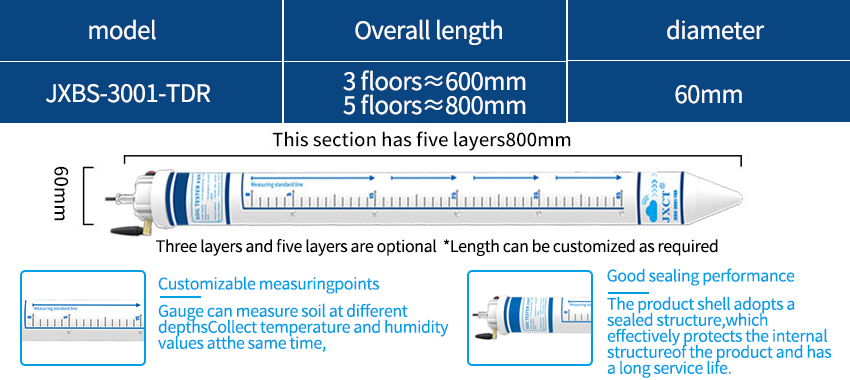background:
Soil moisture sensor, also known as: soil moisture sensor, soil moisture sensor, soil moisture sensor, is mainly used to measure soil volumetric water content. Soil moisture sensors commonly used in soil moisture monitoring and agricultural irrigation and forestry protection are FDR type and TDR type, namely frequency domain type and time domain type. At present, the FDR type is more popular, and the FDR frequency domain reflectometer is an instrument used to measure soil moisture. It is simple, safe, fast and accurate. Fixed-point continuous, automatic, wide range, less calibration and other advantages.
At present, there are many methods for soil moisture determination at home and abroad. In turn there are different soil moisture sensors. For example: time domain reflectometry (TDR), gypsum method, infrared remote sensing method, frequency domain reflectometry/frequency domain method (FDR/FD method). Titration method, capacitance method, resistance method, microwave method, neutron method, Karl Fischer method, γ-ray method and nuclear magnetic resonance method, etc. Below we describe how each sensor works.
TDR method moisture sensor:
The TDR method is a soil moisture measurement method developed in the 1980s, which is called time domain reflectometer in Chinese. This method is quite common in foreign countries and has just begun to be introduced in China. All departments attach great importance to it. TDR is a system similar to radar system and has strong independence. The results were largely independent of soil type, density, and temperature. And, importantly, TDR can measure soil moisture under ice. This is unmatched by other methods. In addition, TDR can monitor soil water and salt content at the same time, and there is almost no difference between the results of the two measurements before and after. The strength of this method of measurement is evident.
FDR and FD method moisture sensor:
Because the TDR method is expensive, in the late 1980s, many companies (such as AquaSPY, Sentek. Delta-T, Decagon) began to use a simpler method than TDR to measure the dielectric constant of soil. FDR and FD methods are not only cheaper than TDR, but also have shorter measurement times. After a specific soil calibration, the measurement accuracy is high. Moreover, the shape of the probe is not limited, and multiple depths can be measured at the same time, making data acquisition easier.
Resistance method moisture sensor:
The electrical resistance method utilizes the electrical resistance of gypsum, nylon, glass fiber, etc. and their water content. When these intermediates plus electrodes are placed in moist soil, and after a period of time, the moisture content of these things reaches equilibrium. Due to the relationship between resistance and water content, we previously calibrated a certain correspondence between resistance and percentage. These components can then be used to obtain moisture readings in the suction range of 1 to 15 atmospheres.
Neutron scattering (neutron scattering) moisture sensor:
The neutron method is suitable for the determination of soil moisture in the field. It is based on the principle that hydrogen drastically reduces the speed of fast neutrons and scatters them, and neutron moisture meters for soil moisture measurement are now available on the market. Neutron moisture meters have many advantages, but have considerable limitations on organic soils. And it is not suitable for measuring the soil moisture content of 0-15cm.
Y-ray moisture sensor:
Similar to the neutron instrument, the ray transmission method uses the radioactive source 137Cs to emit a ray, and the probe receives the energy of the ray after passing through the soil, which is converted from the soil moisture content.

Jingxun Unblocked Water Potential Sensor:
Soil moisture meters, soil testers and soil meters are sensors based on the principle of dielectric constant. It can dynamically observe the content of soil parameters in different soil layers, and conduct fast, accurate and comprehensive observations. So that people’s understanding of soil to a higher level. The soil parameter rapid measuring instrument adopts the TDR non-contact measurement method, and measures the feedback signal reflected by the soil by transmitting a high-frequency pulse signal. According to this principle, the soil water content data is calculated. Compared with the standard drying method, the data difference of the soil parameter rapid tester is only ±3%. TDR non-contact measurement can simultaneously measure soil moisture and temperature data in different soil layers because the sensor does not actually contact the soil. Make fast, accurate and comprehensive observations. The overall shell of the soil parameter rapid tester is made of new ABS material, which has a high repetition rate and a designed service life of up to 10 years.

3 in 1 soil sensor:
The soil moisture sensor adopts the international new generation FDR measurement method, and the accuracy can reach below 3%. Using electromagnetic non-contact measurement, the soil moisture sensor will not drift over time. Greatly enhances the stability of the product and prolongs the service life. The high-density epoxy resin is used for high-temperature vacuum filling between the probe and the fuselage. It can prevent moisture from entering the inside of the fuselage and has better sealing performance. In addition to the combined part, we also waterproof and dustproof the entire body to ensure the long-term operation of the components. We use austenitic 316 stainless steel as the raw material for the probe part. It has rust resistance, electrolysis resistance, and salt-alkali corrosion resistance, which ensures the long-term work of the probe part. Therefore, it is suitable for all kinds of soils.